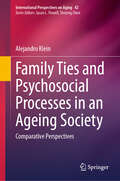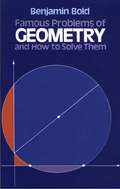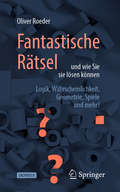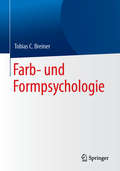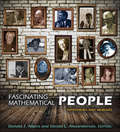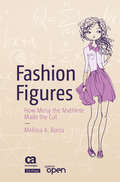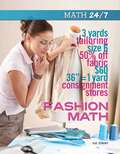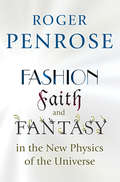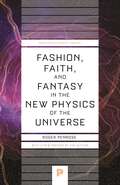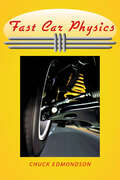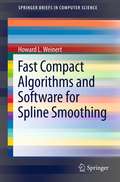- Table View
- List View
Family Ties and Psychosocial Processes in an Ageing Society: Comparative Perspectives (International Perspectives on Aging #42)
by Alejandro KleinThis book contributes to the discussion on the ageing society by addressing the new psycho-social structures of the ageing society, the problems around family bonds and ties, and the structures of care and protection. The book sheds light on the new roles of grandparents and new grandparents, and the empowerment and resilience initiatives, thereby providing a broad discussion of what the ageing society implies in psychosocial terms. These issues are addressed in an interdisciplinary way, but also in an approach that is also rare, comparing different realities between Europe and Latin America. The [basis of the] English translation of this book from its Spanish original manuscript was done with the help of artificial intelligence. A subsequent human revision of the content was done by the author.
Famous Problems of Geometry and How to Solve Them (Dover Books on Mathematics)
by Benjamin BoldIt took two millennia to prove the impossible; that is, to prove it is not possible to solve some famous Greek problems in the Greek way (using only straight edge and compasses). In the process of trying to square the circle, trisect the angle and duplicate the cube, other mathematical discoveries were made; for these seemingly trivial diversions occupied some of history's great mathematical minds. Why did Archimedes, Euclid, Newton, Fermat, Gauss, Descartes among so many devote themselves to these conundrums? This book brings readers actively into historical and modern procedures for working the problems, and into the new mathematics that had to be invented before they could be "solved."The quest for the circle in the square, the trisected angle, duplicated cube and other straight-edge-compass constructions may be conveniently divided into three periods: from the Greeks, to seventeenth-century calculus and analytic geometry, to nineteenth-century sophistication in irrational and transcendental numbers. Mathematics teacher Benjamin Bold devotes a chapter to each problem, with additional chapters on complex numbers and analytic criteria for constructability. The author guides amateur straight-edge puzzlists into these fascinating complexities with commentary and sets of problems after each chapter. Some knowledge of calculus will enable readers to follow the problems; full solutions are given at the end of the book.Students of mathematics and geometry, anyone who would like to challenge the Greeks at their own game and simultaneously delve into the development of modern mathematics, will appreciate this book. Find out how Gauss decided to make mathematics his life work upon waking one morning with a vision of a 17-sided polygon in his head; discover the crucial significance of eπi = -1, "one of the most amazing formulas in all of mathematics." These famous problems, clearly explicated and diagrammed, will amaze and edify curious students and math connoisseurs.
Fantastische Rätsel und wie Sie sie lösen können: Logik, Wahrscheinlichkeit, Geometrie, Spiele und mehr!
by Oliver RoederDie 49 verblüffendsten, beliebtesten und interessantesten Mathematikrätsel der Kolumne „The Riddler“ auf der Nachrichtenseite „FiveThirtyEight“ sind in diesem Buch für das kleine (oder größere) Rätselabenteuer zwischendurch gesammelt. Erforschen Sie dabei alltägliche Vorkommnisse mit Mathematik und Verstand:Wie Sie am besten Ihr Smartphone fallen lassenKönnen Sie den unsteten Prinzen finden?Die Quadratur des QuadratsVorsicht mit dem Martini-Glas!Können Sie die Alien-Invasion stoppen?Besetzt oder nicht besetzt – das ist hier die FrageUnd wenn Roboter Ihre Pizza schneiden?Werden Sie (ja Sie!) die Wahl entscheiden? Und vieles mehr! Die einfachsten Rätsel erfordern bloß einen Geistesblitz, während Sie für die schwierigsten schon ein gewisses Geschick in Analysis und Wahrscheinlichkeitstheorie benötigen. Die „Fantastischen Rätsel“ sind ein Muss für jeden Mathematik- oder Rätselliebhaber! "Ein modernes, intelligentes Rätselbuch, wie ich es noch nie zuvor gesehen habe, dessen mathematische und logische Herausforderungen Ihr Gehirn auf neue Art und Weise fordern werden" - Will Shortz, New York Times, NPR-PuzzlemasterDer HerausgeberOliver Roeder war Redakteur bei FiveThirtyEight und Herausgeber der mathematischen Kolumne „The Riddler“. Er hat in Wirtschaftswissenschaften mit Schwerpunkt Spieltheorie promoviert und war Nieman fellow an der Harvard University 2020. Er lebt in Brooklyn, New York.
Farb- und Formpsychologie
by Tobias C. BreinerDieses Werk ist eine umfassende und praxisrelevante Darstellung zur Farb- und Formpsychologie. Mit einer klaren Sprache und über 100 farbigen Abbildungen wird Ihnen die komplexe Thematik auf eine wissenschaftliche und anregende Art veranschaulicht.Über eine allgemeine Einführung in die Grundlagen des visuellen Systems hinaus werden Sie ebenfalls spezielles Wissen zu Assoziationen, Wirkungen und Anwendungen bestimmter Farben und Formen erwerben. Speziellen Wert legt der Autor dabei auf deren Einsatz im Game Design. Es wird zudem erstmals eine neue Farbstudie präsentiert, die zeigt, dass die Assoziationen zu Farben sich in einem in sich logischen dreidimensionalen System anordnen lassen. Die daraus gezogenen überraschenden Erkenntnisse liefern mögliche Antworten auf fundamentale Fragen der Philosophie. Das Buch ist daher nicht nur ein Muss für Wahrnehmungspsychologen und Designer, sondern eine Bereicherung für alle an dieser Thematik Interessierten.
Fascinating Mathematical People
by Philip J. Davis Gerald L. Alexanderson Donald J. AlbersFascinating Mathematical People is a collection of informal interviews and memoirs of sixteen prominent members of the mathematical community of the twentieth century, many still active. The candid portraits collected here demonstrate that while these men and women vary widely in terms of their backgrounds, life stories, and worldviews, they all share a deep and abiding sense of wonder about mathematics. Featured here--in their own words--are major research mathematicians whose cutting-edge discoveries have advanced the frontiers of the field, such as Lars Ahlfors, Mary Cartwright, Dusa McDuff, and Atle Selberg. Others are leading mathematicians who have also been highly influential as teachers and mentors, like Tom Apostol and Jean Taylor. Fern Hunt describes what it was like to be among the first black women to earn a PhD in mathematics. Harold Bacon made trips to Alcatraz to help a prisoner learn calculus. Thomas Banchoff, who first became interested in the fourth dimension while reading a Captain Marvel comic, relates his fascinating friendship with Salvador Dalí and their shared passion for art, mathematics, and the profound connection between the two. Other mathematical people found here are Leon Bankoff, who was also a Beverly Hills dentist; Arthur Benjamin, a part-time professional magician; and Joseph Gallian, a legendary mentor of future mathematicians, but also a world-renowned expert on the Beatles. This beautifully illustrated collection includes many photographs never before published, concise introductions by the editors to each person, and a foreword by Philip J. Davis.
Fashion Figures
by Melissa A. BorzaMissy Maker is a middle school girl who loves math and fashion. She sees math in everything she does. She tries to hide this from her friends, because she thinks it's too geeky. Missy hears that the school math club needs more members, but she's worried about what her friends will think if she joins, and she's already committed to joining the fashion club. After an epic internal struggle and with the support of her peers and her quirky, loving family, Missy finds that she can be both a Mathlete and a Fashionista. Missy figures out how to bring the two clubs together to help both groups win. In the process, she discovers that she can openly excel in math and science and still be popular with her peers. She also learns how her math and science skills can help her artistic endeavors. Gain an inside perspective on what it's like when you love math and science and happen to be a girl. Fashion Figures highlights the societal and internal pressures preteen and early-teen girls often face when they excel in these subjects, and it shows strategies for overcoming barriers to being themselves and doing what they love while still fitting in socially. What You'll Learn Girls can have a passion for STEM (science, technology, engineering and math) subjects and still be cool Girls can be great at math Math skills are important in non-STEM centered subject areas like fashion and art Math can be fun Who This Book Is For Pre-teen and early-teen girls (9-14 years old)
Fashion Math (Math 24/7 #10)
by Rae SimonsPeople who make clothes need to get their numbers right. From the length of fabric to the size of a pair of jeans, math plays an important role in the fashion industry. In Fashion Math, you'll learn some of the ways the math you learn in the classroom is important on the catwalk. You may even want to use that math to try your hand at making your own clothes!
Fashion, Faith, and Fantasy in the New Physics of the Universe
by Roger PenroseWhat can fashionable ideas, blind faith, or pure fantasy possibly have to do with the scientific quest to understand the universe? Surely, theoretical physicists are immune to mere trends, dogmatic beliefs, or flights of fancy? In fact, acclaimed physicist and bestselling author Roger Penrose argues that researchers working at the extreme frontiers of physics are just as susceptible to these forces as anyone else. In this provocative book, he argues that fashion, faith, and fantasy, while sometimes productive and even essential in physics, may be leading today's researchers astray in three of the field's most important areas--string theory, quantum mechanics, and cosmology.Arguing that string theory has veered away from physical reality by positing six extra hidden dimensions, Penrose cautions that the fashionable nature of a theory can cloud our judgment of its plausibility. In the case of quantum mechanics, its stunning success in explaining the atomic universe has led to an uncritical faith that it must also apply to reasonably massive objects, and Penrose responds by suggesting possible changes in quantum theory. Turning to cosmology, he argues that most of the current fantastical ideas about the origins of the universe cannot be true, but that an even wilder reality may lie behind them. Finally, Penrose describes how fashion, faith, and fantasy have ironically also shaped his own work, from twistor theory, a possible alternative to string theory that is beginning to acquire a fashionable status, to "conformal cyclic cosmology," an idea so fantastic that it could be called "conformal crazy cosmology."The result is an important critique of some of the most significant developments in physics today from one of its most eminent figures.
Fashion, Faith, and Fantasy in the New Physics of the Universe (Princeton Science Library)
by Roger PenroseNobel Prize–winning physicist Roger Penrose questions some of the most fashionable ideas in physics today, including string theoryWhat can fashionable ideas, blind faith, or pure fantasy possibly have to do with the scientific quest to understand the universe? Surely, theoretical physicists are immune to mere trends, dogmatic beliefs, or flights of fancy? In fact, acclaimed physicist and bestselling author Roger Penrose argues that researchers working at the extreme frontiers of physics are just as susceptible to these forces as anyone else. In this provocative book, he argues that fashion, faith, and fantasy, while sometimes productive and even essential in physics, may be leading today's researchers astray in three of the field's most important areas—string theory, quantum mechanics, and cosmology.Arguing that string theory has veered away from physical reality by positing six extra hidden dimensions, Penrose cautions that the fashionable nature of a theory can cloud our judgment of its plausibility. In the case of quantum mechanics, its stunning success in explaining the atomic universe has led to an uncritical faith that it must also apply to reasonably massive objects, and Penrose responds by suggesting possible changes in quantum theory. Turning to cosmology, he argues that most of the current fantastical ideas about the origins of the universe cannot be true, but that an even wilder reality may lie behind them. Finally, Penrose describes how fashion, faith, and fantasy have ironically also shaped his own work, from twistor theory, a possible alternative to string theory that is beginning to acquire a fashionable status, to "conformal cyclic cosmology," an idea so fantastic that it could be called "conformal crazy cosmology."The result is an important critique of some of the most significant developments in physics today from one of its most eminent figures.
Fast Car Physics
by Chuck EdmondsonRevving engines, smoking tires, and high speeds. Car racing enthusiasts and race drivers alike know the thrill of competition, the push to perform better, and the agony—and dangers—of bad decisions. But driving faster and better involves more than just high horsepower and tightly tuned engines. Physicist and amateur racer Chuck Edmondson thoroughly discusses the physics underlying car racing and explains just what’s going on during any race, why, and how a driver can improve control and ultimately win.The world of motorsports is rich with excitement and competition—and physics. Edmondson applies common mathematical theories to real-world racing situations to reveal the secrets behind successful fast driving. He explains such key concepts as how to tune your car and why it matters, how to calculate 0 to 60 mph times and quarter-mile times and why they are important, and where, when, why, and how to use kinematics in road racing. He wraps it up with insight into the impact and benefit of green technologies in racing. In each case, Edmondson’s in-depth explanations and worked equations link the physics principles to qualitative racing advice.From selecting shifting points to load transfer in car control and beyond, Fast Car Physics is the ideal source to consult before buckling up and cinching down the belts on your racing harness.
Fast Compact Algorithms and Software for Spline Smoothing
by Howard L. WeinertFast Compact Algorithms and Software for Spline Smoothing investigates algorithmic alternatives for computing cubic smoothing splines when the amount of smoothing is determined automatically by minimizing the generalized cross-validation score. These algorithms are based on Cholesky factorization, QR factorization, or the fast Fourier transform. All algorithms are implemented in MATLAB and are compared based on speed, memory use, and accuracy. An overall best algorithm is identified, which allows very large data sets to be processed quickly on a personal computer.
Fast Computation of Volume Potentials by Approximate Approximations (Lecture Notes in Mathematics #2378)
by Gunther Schmidt Vladimir Maz'ya Flavia LanzaraThis book introduces a new fast high-order method for approximating volume potentials and other integral operators with singular kernel. These operators arise naturally in many fields, including physics, chemistry, biology, and financial mathematics. A major impediment to solving real world problems is the so-called curse of dimensionality, where the cubature of these operators requires a computational complexity that grows exponentially in the physical dimension. The development of separated representations has overcome this curse, enabling the treatment of higher-dimensional numerical problems. The method of approximate approximations discussed here provides high-order semi-analytic cubature formulas for many important integral operators of mathematical physics. By using products of Gaussians and special polynomials as basis functions, the action of the integral operators can be written as one-dimensional integrals with a separable integrand. The approximation of a separated representation of the density combined with a suitable quadrature of the one-dimensional integrals leads to a separated approximation of the integral operator. This method is also effective in high-dimensional cases. The book is intended for graduate students and researchers interested in applied approximation theory and numerical methods for solving problems of mathematical physics.
Fast Fourier Transform - Algorithms and Applications
by Jae Jeong Hwang K. R. Rao Do Nyeon KimThis book presents an introduction to the principles of the fast Fourier transform. This book covers FFTs, frequency domain filtering, and applications to video and audio signal processing. As fields like communications, speech and image processing, and related areas are rapidly developing, the FFT as one of essential parts in digital signal processing has been widely used. Thus there is a pressing need from instructors and students for a book dealing with the latest FFT topics. This book provides thorough and detailed explanation of important or up-to-date FFTs. It also has adopted modern approaches like MATLAB examples and projects for better understanding of diverse FFTs.
Fast Fourier Transforms (Studies in Advanced Mathematics #24)
by James S. WalkerThis new edition of an indispensable text provides a clear treatment of Fourier Series, Fourier Transforms, and FFTs. The unique software, included with the book and newly updated for this edition, allows the reader to generate, firsthand, images of all aspects of Fourier analysis described in the text. Topics covered include :
Fast Future: How the Millennial Generation Is Shaping Our World
by David D. BursteinA millennial examines how his generation is profoundly impacting politics, business, media, and activismThey've been called trophy kids, entitled, narcissistic, the worst employees in history, and even the dumbest generation. But, argues David Burstein, the millennial generation's unique blend of civic idealism and savvy pragmatism will enable us to overcome a deeply divided nation facing economic and environmental calamities.With eighty-million millennials (people who are today eighteen to thirty years old) coming of age and emerging as leaders, this is the largest generation in U.S. history, and, by 2020, its members will represent one out of every three adults. They are more ethnically and racially diverse than their elders and have begun their careers at a time when the recession has set back the job market. Yet they remain optimistic about their future and are deeply connected to one another. Drawing on extensive interviews with his millennial peers and compelling new research, Burstein illustrates how his generation is simultaneously shaping and being shaped by a fast-paced and fast-changing world.Part oral history, part social documentary, Fast Future reveals the impact and story of the millennial generation--in its own words.
Fast Matrix Multiplication with Applications (Studies in Big Data #166)
by Jerzy S. RespondekThe ambition of this monograph is to show the methods of constructing fast matrix multiplication algorithms, and their applications, in an intelligible way, accessible not only to mathematicians. The scope and coverage of the book are comprehensive and constructive, and the analyses and algorithms can be readily applied by readers from various disciplines of science and technology who need modern tools and techniques related to fast matrix multiplication and related problems and techniques. Authors start from commutative algorithms, through exact non-commutative algorithms, partial algorithms to disjoint and arbitrary precision algorithms. Authors explain how to adapt disjoint algorithms to a single matrix multiplication and prove the famous tau-theorem in the (not so) special case. In an appendix, authors show how to work with confluent Vandermonde matrices, since they are used as an auxiliary tool in problems arising in fast matrix multiplication. Importantly, each algorithm is demonstrated by a concrete example of a decent dimensionality to ensure that all the mechanisms of the algorithms are illustrated. Finally, authors give a series of applications of fast matrix multiplication algorithms in linear algebra and other types of problems, including artificial intelligence.
Fast Multipole Boundary Element Method
by Yijun LiuThe fast multipole method is one of the most important algorithms in computing developed in the 20th century. Along with the fast multipole method, the boundary element method (BEM) has also emerged, as a powerful method for modeling large-scale problems. BEM models with millions of unknowns on the boundary can now be solved on desktop computers using the fast multipole BEM. This is the first book on the fast multipole BEM, which brings together the classical theories in BEM formulations and the recent development of the fast multipole method. Two- and three-dimensional potential, elastostatic, Stokes flow, and acoustic wave problems are covered, supplemented with exercise problems and computer source codes. Applications in modeling nanocomposite materials, bio-materials, fuel cells, acoustic waves, and image-based simulations are demonstrated to show the potential of the fast multipole BEM. This book will help students, researchers, and engineers to learn the BEM and fast multipole method from a single source.
Fast Sequential Monte Carlo Methods for Counting and Optimization
by Reuven Y. Rubinstein Radislav Vaisman Ad RidderA comprehensive account of the theory and application of Monte Carlo methodsBased on years of research in efficient Monte Carlo methods for estimation of rare-event probabilities, counting problems, and combinatorial optimization, Fast Sequential Monte Carlo Methods for Counting and Optimization is a complete illustration of fast sequential Monte Carlo techniques. The book provides an accessible overview of current work in the field of Monte Carlo methods, specifically sequential Monte Carlo techniques, for solving abstract counting and optimization problems.Written by authorities in the field, the book places emphasis on cross-entropy, minimum cross-entropy, splitting, and stochastic enumeration. Focusing on the concepts and application of Monte Carlo techniques, Fast Sequential Monte Carlo Methods for Counting and Optimization includes:Detailed algorithms needed to practice solving real-world problemsNumerous examples with Monte Carlo method produced solutions within the 1-2% limit of relative errorA new generic sequential importance sampling algorithm alongside extensive numerical resultsAn appendix focused on review material to provide additional background informationFast Sequential Monte Carlo Methods for Counting and Optimization is an excellent resource for engineers, computer scientists, mathematicians, statisticians, and readers interested in efficient simulation techniques. The book is also useful for upper-undergraduate and graduate-level courses on Monte Carlo methods.
Fast Solar Sailing
by Giovanni VulpettiThe range of solar sailing is very vast; it is a fully in-space means of propulsion that should allow us to accomplish various mission classes that are literally impossible using rocket propulsion, no matter if nuclear or electric. Fast and very fast solar sailings are special classes of sailcraft missions, initially developed only in the first half of the 1990s and still evolving, especially after the latest advances in nanotechnology. This book describes how to plan, compute and optimize the trajectories of sailcraft with speeds considerably higher than 100 km/s; such sailcraft would be able to explore the outer heliosphere, the near interstellar medium and the solar gravitational lens (550-800 astronomical units) in times significantly shorter than the span of an average career (~ 35 years), just to cite a few examples. The scientific interest in this type of exploration is huge.
Fast Solvers for Mesh-Based Computations (Advances in Applied Mathematics)
by Maciej PaszynskiFast Solvers for Mesh-Based Computations presents an alternative way of constructing multi-frontal direct solver algorithms for mesh-based computations. It also describes how to design and implement those algorithms.The book's structure follows those of the matrices, starting from tri-diagonal matrices resulting from one-dimensional mesh-based meth
Fast Track to Differential Equations: Applications-Oriented – Comprehensible – Compact
by Albert FässlerThis compact introduction to the ordinary differential equations and their applications is aimed at anyone who, in their studies, is confronted voluntarily or involuntarily with this versatile subject. Numerous examples from physics, technology, biomathematics, cosmology, economy and optimization allow a quick and motivating approach - abstract proofs and unnecessary formalism are avoided as far as possible. In the foreground is the modelling of ordinary differential equations of the 1st and 2nd order as well as their analytical and numerical solution methods, in which the theory is briefly dealt with before the application examples. In addition, codes show exemplarily how even more demanding questions can be answered and meaningfully represented with the help of a computer algebra system. In the first chapter the necessary previous knowledge from integral and differential calculus is treated. A large number of exercises including solutions round off the work.
Fast Track: Essential Review for AP, Honors, and Other Advanced Study (High School Subject Review)
by The Princeton ReviewGET UP TO SPEED WITH FAST TRACK: GEOMETRY! Covering the most important material taught in high school geometry classes, this essential review book gets readers on the fast track to class success, with critical information presented in an easy-to-follow quick-study format!Inside this book, you'll find:• Clear, concise summaries of the most important concepts, formulas, and geometric skills• Diagrams, charts, and graphs for quick visual reference• Easy-to-follow content organization and illustrationsWith its friendly, straightforward approach and a clean, colorful modern design crafted to appeal to visual learners, this guidebook is perfect for catching up in class or getting ahead on exam review.Topics covered in Fast Track: Geometry include:• Key terms• Angles• Polygons• Circles• Congruence and similarity• Constructions• Transformations• Trigonometry• Three-dimensional figures• Reasoning and proofs• Perimeter, area, and volume... and more!
Fast Transverse Beam Instability Caused by Electron Cloud Trapped in Combined Function Magnets (Springer Theses)
by Sergey A. AntipovThis thesis presents profound insights into the origins and dynamics of beam instabilities using both experimental observations and numerical simulations. When the Recycler Ring, a high-intensity proton beam accelerator at Fermi National Accelerator Laboratory, was commissioned, it became evident that the Recycler beam experiences a very fast instability of unknown nature. This instability was so fast that the existing dampers were ineffective at suppressing it. The nature of this phenomenon, alongside several other poorly understood features of the beam, became one of the biggest puzzles in the accelerator community. The author investigated a hypothesis that the instability arises from an interaction with a dense cloud of electrons accompanying the proton beam. He studied the phenomena experimentally by comparing the dynamics of stable and unstable beams, by numerically simulating the build-up of the electron cloud and its interaction with the beam, and by constructing an analytical model of an electron cloud-driven instability with the electrons trapped in combined-function dipole magnets. He has devised a method to stabilize the beam by a clearing bunch, which conclusively revealed that the instability is caused by the electron cloud, trapped in a strong magnetic field. Finally, he conducted measurements of the microwave propagation through a single dipole magnet. These measurements have confirmed the presence of the electron cloud in combined-function magnets.
Fast Variables in Stochastic Population Dynamics
by George William Albert ConstableIn this thesis two variants of the fast variable elimination method are developed. They are intuitive, simple to implement and give results which are in very good agreement with those found from numerical simulations. The relative simplicity of the techniques makes them ideal for applying to problems featuring demographic stochasticity, for experts and non-experts alike. Within the context of mathematical modelling, fast variable elimination is one of the central tools with which one can simplify a multivariate problem. When used in the context of of deterministic systems, the theory is quite standard, but when stochastic effects are present, it becomes less straightforward to apply. While the introductory and background chapters form an excellent primer to the theory of stochastic population dynamics, the techniques developed can be applied to systems exhibiting a separation of timescales in a variety of fields including population genetics, ecology and epidemiology.
Faster Isn't Smarter: Messages about Math, Teaching, and Learning in the 21st Century
by Cathy L. SeeleyFeaturing 41 entirely updated messages and four new ones, this second edition continues to offer straight talk and common sense about some of today's most important, thought-provoking issues in education. With themes ranging from equity, intelligence, and the incredible potential of all students to challenging students to think with a problem-centered approach focused on student engagement and classroom discourse, the book provides a base for lively discussion among elementary, middle, and high school teachers; leaders; policymakers; and families. Entirely updated, including new messages.
